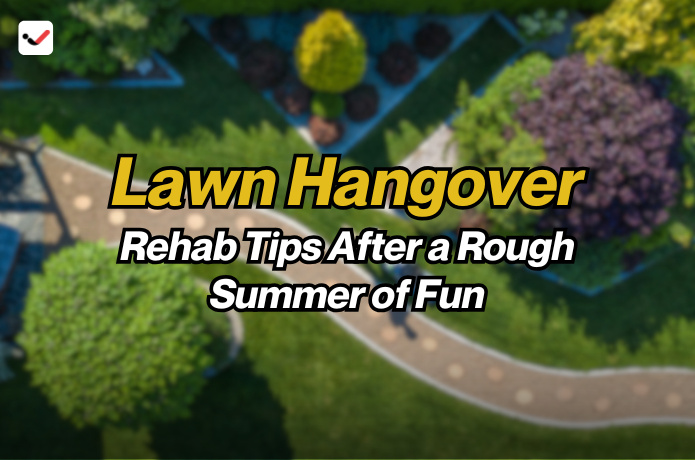Lawn Hangover: Rehab Tips After a Rough Summer of Fun
Lawn Hangover: Rehab Tips After a Rough Summer of Fun

After months of backyard barbecues, kids running around, lawn games, and sun-soaked afternoons, your yard is probably showing signs of wear. Dead patches, thin grass, soil compaction, and dried-out spots are common once summer ends. All that fun can leave your lawn looking tired and in need of some serious recovery.
Now is the time to fix the damage. With the right steps, you can bring your lawn back to life and prep it for cooler weather. These post-summer lawn care tips are easy to follow and make a big difference. Whether you're dealing with heavy foot traffic areas or just general stress from heat and drought, these lawn repair after summer strategies will help you get back on track.
Assess the Damage
Start by walking your lawn and taking note of problem areas. Look for bare patches, thinning grass, discolored spots, and compacted soil. Make a list so you can target each issue instead of guessing. A lawn that’s been through summer parties and heat waves needs more than just mowing.
If your lawn feels hard underfoot or looks dull even after watering, chances are it needs more attention than usual. Creating a rehab plan based on the visible damage is the first step in learning how to fix damaged grass effectively.
Clear Out Dead Debris
Before anything new can grow, you need to clean up what’s left behind. Rake up dead grass, leaves, and any leftover debris. Removing the thatch (the layer of dead material sitting on top of the soil) will help air, water, and nutrients reach the roots more easily.
Use a dethatching rake or rent a dethatching machine if your yard is large. Clearing the surface helps prepare the lawn for the next steps and allows new seed or fertilizer to settle into the soil better.
Aerate Your Lawn
One of the most important steps in reviving dead grass is lawn aeration. Summer activity compacts the soil, which blocks water and nutrients from getting to the roots. Aerating breaks up the soil and allows everything your grass needs to reach the root zone.
Use a core aerator to pull small plugs of soil out of the ground. This opens up the lawn and improves drainage. Fall is the perfect time to do this because the cooler temps support root growth without stressing the grass.
Overseed Bare and Thin Areas
After aerating, it’s time to overseed your lawn. This means spreading fresh grass seed over existing grass and bare spots. Choose a seed blend that matches your current grass type and is suited for your region. Cool-season grasses thrive when planted in early fall.
Use a broadcast spreader for even coverage, and lightly rake the soil afterward to help the seeds settle. Water daily for two weeks or until new grass reaches mowing height. This step is essential in lawn repair after summer, especially in areas that saw a lot of foot traffic or heat stress.
Apply Fertilizer for Recovery
Give your lawn the nutrients it needs to recover with a fall lawn treatment. Use a fertilizer high in nitrogen to support blade growth and potassium to strengthen roots. This will help your grass recover from summer damage and build resilience for winter.
Apply fertilizer right after aerating and seeding to maximize the benefits. Water the lawn thoroughly after applying it, and follow the instructions on the label for best results. Feeding your lawn now means a healthier, greener yard come spring.
Fix Compacted or Worn-Out Spots
Areas like pathways, play zones, or near patios can become too compacted for grass to grow. If the soil is hard and bare, loosen it with a shovel or garden fork. Mix in compost or topsoil to improve drainage and texture.
Then seed, water, and cover with straw or mulch to hold moisture. These small patches often need extra care, but with patience, you’ll see new growth in just a few weeks. Knowing how to fix damaged grass in these high-traffic zones can make a big visual impact.
Adjust Watering Schedule
After a dry summer, your lawn may still be thirsty. Shift to a deep watering routine—once or twice a week—to encourage deep root growth. Shallow watering causes weak roots and won’t support long-term recovery.
Use sprinklers or soaker hoses early in the morning to reduce evaporation. Keep the soil moist, especially in newly seeded areas. Regular watering helps both old and new grass grow strong before colder weather hits.
Keep Mowing—but Less Often
Even while your lawn is recovering, it still needs mowing. Keep your grass around 2.5 to 3 inches tall to shade the soil and protect the roots. Don’t cut more than one-third of the grass height at a time to avoid stressing it.
Sharp mower blades make clean cuts and reduce the risk of disease. Mow every 7–10 days or as needed, depending on how fast your grass grows. This helps maintain a neat look while supporting healthy regrowth.
Weed Control and Prevention
Weeds love to move into weak lawns, especially after summer stress. Pull out any large weeds by hand and apply a selective herbicide for broadleaf weeds like clover or dandelions. Be cautious when applying herbicides around new grass seedlings.
To prevent future weed problems, keep your lawn thick and healthy. Dense grass naturally crowds out weeds. Strong turf is the best long-term defense against invasive plants.
Mulch and Edge for a Finished Look
To make your lawn look cared for while it recovers, touch up the edges around sidewalks, driveways, and flower beds. A clean edge gives your yard a crisp look even if the grass is still filling in.
Fresh mulch around trees and garden beds also helps retain soil moisture and keeps things tidy. These finishing touches go a long way when you're managing a post-summer lawn care routine.
Get Your Lawn Back on Track
A rough summer can leave your lawn looking worn out, but it doesn’t have to stay that way. With the right mix of cleanup, aeration, overseeding, and proper feeding, you can reverse the damage. These lawn rehab tips don’t take much time but give big results when done right.
Fall is your best chance to heal your grass and set it up for success next year. Whether you're working on how to fix damaged grass or planning for long-term lawn health, acting now makes all the difference. Give your lawn what it needs—and it will come back greener, stronger, and ready for whatever next summer brings.

